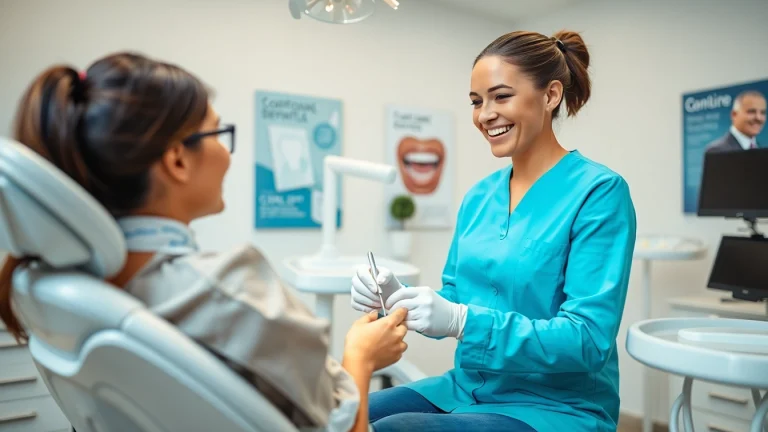
Understanding Dental Cleanings: Importance, Process, and Benefits for Your Oral Health
1. What Are Dental Cleanings?
1.1 Definition and Purpose of Dental Cleanings
Dental cleanings are professional oral hygiene procedures performed by dentists or dental hygienists aimed at maintaining and improving oral health. During these cleanings, dental professionals remove plaque, tartar, and bacteria buildup from the teeth and gum line, preventing potential oral diseases. The main purpose is to foster a healthy mouth and detect early signs of dental issues before they escalate into more serious conditions. For a more comprehensive overview of the significance of dental cleanings, it is crucial to understand their impact on overall health.
1.2 Importance of Regular Dental Cleanings
Regular dental cleanings are paramount for maintaining optimal oral hygiene. They are recommended biannually or as directed by your dental professional. These cleanings help in the prevention of cavities, gum disease, and other dental complications. The removal of plaque and tartar not only keeps your teeth clean but also can minimize the risk of heart disease and diabetes, as oral health is closely linked to overall health. Furthermore, regular visits allow dental practitioners to catch any early signs of oral cancers or other systemic issues.
1.3 Common Misconceptions About Dental Cleanings
There are several misconceptions surrounding dental cleanings that can deter individuals from seeking them regularly. One common belief is that dental cleanings are painful; however, most patients experience little to no discomfort. Another misconception is that if you brush and floss regularly, dental cleanings are unnecessary, which is false. While good home care is vital, professional cleanings remove harder deposits and stains that routine brushing cannot. Addressing these misconceptions helps encourage more people to prioritize their dental health.
2. The Dental Cleaning Process Explained
2.1 Initial Examination Before Dental Cleanings
The dental cleaning process begins with an initial examination where the dental professional assesses your dental health. This includes checking for any signs of cavities, gum disease, and overall oral health. X-rays may be taken to detect underlying issues that aren’t visible to the naked eye, allowing for a more comprehensive understanding of the patient’s dental landscape. This initial evaluation is critical and sets the groundwork for the cleaning process.
2.2 Steps Involved in a Typical Dental Cleaning
A typical dental cleaning involves several structured steps:
- Scaling: The dental hygienist uses specialized tools to remove plaque and tartar from the surface of the teeth and below the gum line.
- Polishing: Once scaling is complete, the teeth are polished with a gritty toothpaste and a rotating brush, which helps to remove stains and smooth the tooth surface.
- Flossing: A thorough flossing is performed to clean between the teeth, ensuring no debris is left behind.
- Final Examination: Finally, the dentist examines the cleaned teeth and gums, discussing any necessary further actions or treatments with the patient.
2.3 Tools Used During Dental Cleanings
Several tools are essential in conducting an effective dental cleaning. These typically include:
- Scaler: A manual or ultrasonic scaler is used to remove tartar and plaque buildup.
- Polishing Tool: A high-speed handpiece equipped with rubber cups or brushes for polishing the teeth.
- Explorer: A pointed instrument used to check for cavities and calculus on tooth surfaces.
- Prophy Angle: A device that attaches to the dental handpiece and effectively polishes teeth.
3. Different Types of Dental Cleanings
3.1 Routine Dental Cleanings vs. Deep Cleanings
Routine dental cleanings, also known as preventive cleanings, are suitable for patients with healthy gums and teeth. These cleanings remove surface-level debris and tartar twice a year. Deep cleanings, on the other hand, are necessary for patients with periodontal disease. This procedure, often called scaling and root planing, involves cleaning both above and below the gum line, addressing tartar deposits that may lead to gum deterioration if left untreated.
3.2 Specialized Dental Cleanings for Periodontal Disease
Patients diagnosed with gum disease may require a specialized cleaning regimen. This involves more intensive cleaning methods aimed at the pockets below the gum line. Treatments may include scaling, root planing, and sometimes the use of antibiotics to combat infection and inflammation. A tailored hygiene routine will typically be prescribed by a dental professional to ensure the best outcome and recovery of gum health.
3.3 Choosing the Right Type of Dental Cleaning for You
Choosing the right type of dental cleaning depends on individual factors such as the health of your gums, any existing dental issues, and the recommendations of your dentist. Usually, a conversation with your dental professional will guide you in understanding if you need a routine or a specialized cleaning. Regular dental check-ups will help in determining the most appropriate techniques and intervals between cleanings for your specific needs.
4. Benefits of Regular Dental Cleanings
4.1 How Dental Cleanings Prevent Oral Diseases
Regular dental cleanings are instrumental in preventing various oral diseases. By removing plaque and tartar, dental cleanings help avoid cavities and gum disease. Furthermore, they play a pivotal role in reducing the risk of bad breath, tooth decay, and serious conditions such as gingivitis and periodontitis. Routine cleanings also contribute to the overall health of the body, preventing bacteria from entering the bloodstream through the gums, which could lead to systemic issues such as cardiovascular diseases.
4.2 Enhancing Aesthetic Appearance Through Dental Cleanings
Beyond health benefits, dental cleanings significantly enhance aesthetic appeal. The polishing step during cleanings effectively removes surface stains, leading to a brighter smile. Regular maintenance helps in preserving the natural color of the teeth and can uplift an individual’s confidence. It’s worth noting that while cleanings improve appearance, they also provide an excellent opportunity to discuss other cosmetic treatments if desired.
4.3 Saving Money with Preventive Dental Cleanings
Investing in regular dental cleanings can lead to substantial long-term savings. Preventive measures help avoid major dental procedures that often come at a higher price. For instance, addressing small cavities during a routine cleaning can prevent the need for fillings or root canals later. Additionally, maintaining good oral health contributes to lower costs associated with dental treatments, making regular cleanings a financially wise choice.
5. Frequently Asked Questions About Dental Cleanings
5.1 How Often Should You Schedule Dental Cleanings?
Most dental professionals recommend scheduling dental cleanings every six months. However, this can vary based on individual oral health needs. Patients with a history of gum disease or other dental issues may need more frequent visits. It’s essential to discuss this schedule with your dental professional to accommodate specific needs and concerns, ensuring optimal oral health.
5.2 What to Expect During Your First Dental Cleaning
For those visiting a dental office for the first time, it’s normal to feel a bit anxious. Your first dental cleaning typically involves discussing your medical history and dental concerns with your hygienist. Expect an initial examination, followed by the cleaning process, which will familiarize you with the tools and techniques used. The process generally takes about 30 to 60 minutes, depending on the health of your teeth and gums.
5.3 Addressing Fears: Are Dental Cleanings Painful?
Many individuals fear that dental cleanings will be painful; however, they are generally painless. While some patients may experience slight discomfort, especially if there is inflammation or tartar buildup, dental professionals prioritize patient comfort and can adjust their methods accordingly. Many offices also offer sedation options for more anxious patients, making the experience more pleasant.


